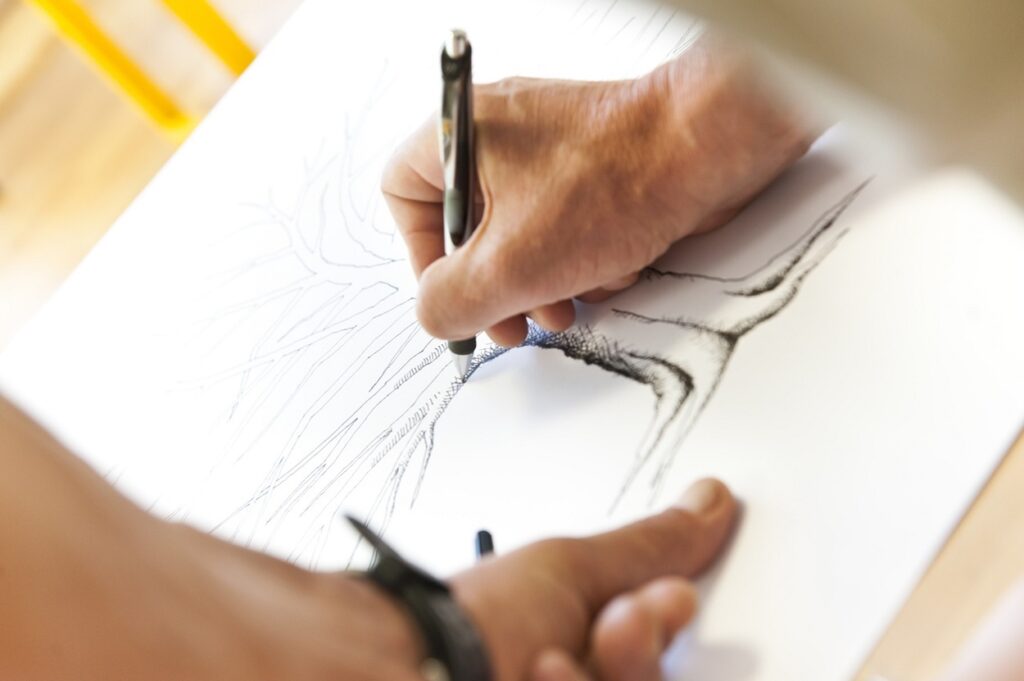Hand drawn graphics are simple images accompanied by text. The terms sketchnoting, graphic facilitation, visual thinking and visual communication all relate to hand drawn graphics.
Organisations can make use of hand drawn graphics in many areas.
For example, a simple one page graphic can be used to explain a complex process; graphic facilitation can be used to make meetings run smoothly and ensure everyone is one the same page; graphic recording can be used to capture the high level points made at a talk or event.
What’s so great about graphics?
What makes graphics great is that they relate to how our brains work. Research tells us that 90% of information that is transmitted to the brain is visual (Source: Hyerle) and over 65% of the population are visual learners (Source: Social Science Research Network).
Essentially many people find it much easier to absorb information from text with images than text alone.
The use of graphics therefore has many advantages.
Key Advantages
- Increased understanding and reduced confusion: because we absorb information from graphics so easily this leads to clarity in communication and increased understanding.
- Greater engagement and participation: greater understanding leads to greater connection to the topic in hand. When used interactively (such as with graphic facilitation) people are engaged, feel heard and are motivated to participate. This is turn leads to…
- Collaborative working which leads to faster and stronger decision making.
- Generation of ideas. Graphics engage both the right side (creativity, intuition) and left side (logic, linear) of the brain. The simple act of drawing out ideas leads not just to the development of these ideas but to brand new ideas too.
The use of simple images in communication dates back to prehistory when cavemen drew stories on the insides of caves. Graphics are not new. They are not a fad and cannot be replaced be the latest app or software.
When not to use graphics
It’s important to note however that graphics are not a tool to be used by everyone for every occasion. The following are common pitfalls:
- Using graphics for graphics sake. Be wary of the temptation to use graphics simply because they are ‘a bit different’.
- Creating graphics without thought given to format, style and colour. Confusing graphics include those with little or no logic trail, inconsistent colour usage and illegible lettering.
- Not tying in the use of graphics with organisational objectives. When a great deal of detail is required, for example, graphics are not suitable. Make sure your use of graphics ties in with your overall objectives.
There are a lot of misconceptions flying around about graphics – that you need to be ‘good at art’ to use them, that the finished output is the most important thing (when often the process involved to arrive at the finished output carries most weight) or that they only work in certain types of organisations.
Graphics are not about art. They are about getting a message across.
They are about increasing understanding, connecting individuals and teams and reducing conflict and confusion. If your organisation is in the business of communicating ideas you will benefit from the use of graphics.
Whilst it’s certainly not necessary to be ‘good at art’ to fully embrace the advantages of graphics it’s important to learn some basic rules of thumb.
We’ll be exploring this in the next article where we look at making graphics simple and accessible. No degree in fine art required!
Meanwhile think about how graphics can be used in your organisation. Where can they enhance the great work you are already doing? Where can they make life easier? Share your thoughts in the comment box below.
Hand drawn graphics are simple images accompanied by text. The terms sketchnoting, graphic facilitation, visual thinking and visual communication all relate to hand drawn graphics.
Organisations can make use of hand drawn graphics in many areas.
For example, a simple one page graphic can be used to explain a complex process; graphic facilitation can be used to make meetings run smoothly and ensure everyone is one the same page; graphic recording can be used to capture the high level points made at a talk or event.
What’s so great about graphics?
What makes graphics great is that they relate to how our brains work. Research tells us that 90% of information that is transmitted to the brain is visual (Source: Hyerle) and over 65% of the population are visual learners (Source: Social Science Research Network).
Essentially many people find it much easier to absorb information from text with images than text alone.
The use of graphics therefore has many advantages.
Key Advantages
- Increased understanding and reduced confusion: because we absorb information from graphics so easily this leads to clarity in communication and increased understanding.
- Greater engagement and participation: greater understanding leads to greater connection to the topic in hand. When used interactively (such as with graphic facilitation) people are engaged, feel heard and are motivated to participate. This is turn leads to…
- Collaborative working which leads to faster and stronger decision making.
- Generation of ideas. Graphics engage both the right side (creativity, intuition) and left side (logic, linear) of the brain. The simple act of drawing out ideas leads not just to the development of these ideas but to brand new ideas too.
The use of simple images in communication dates back to prehistory when cavemen drew stories on the insides of caves. Graphics are not new. They are not a fad and cannot be replaced be the latest app or software.
When not to use graphics
It’s important to note however that graphics are not a tool to be used by everyone for every occasion. The following are common pitfalls:
- Using graphics for graphics sake. Be wary of the temptation to use graphics simply because they are ‘a bit different’.
- Creating graphics without thought given to format, style and colour. Confusing graphics include those with little or no logic trail, inconsistent colour usage and illegible lettering.
- Not tying in the use of graphics with organisational objectives. When a great deal of detail is required, for example, graphics are not suitable. Make sure your use of graphics ties in with your overall objectives.
There are a lot of misconceptions flying around about graphics – that you need to be ‘good at art’ to use them, that the finished output is the most important thing (when often the process involved to arrive at the finished output carries most weight) or that they only work in certain types of organisations.
Graphics are not about art. They are about getting a message across.
They are about increasing understanding, connecting individuals and teams and reducing conflict and confusion. If your organisation is in the business of communicating ideas you will benefit from the use of graphics.
Whilst it’s certainly not necessary to be ‘good at art’ to fully embrace the advantages of graphics it’s important to learn some basic rules of thumb.
We’ll be exploring this in the next article where we look at making graphics simple and accessible. No degree in fine art required!
Meanwhile think about how graphics can be used in your organisation. Where can they enhance the great work you are already doing? Where can they make life easier? Share your thoughts in the comment box below.








